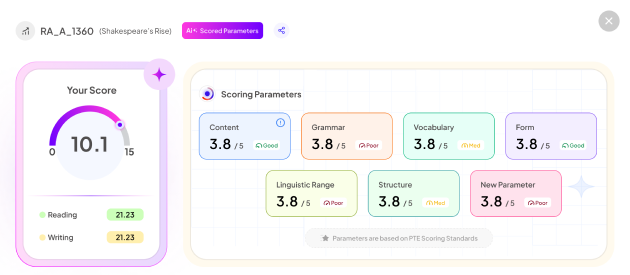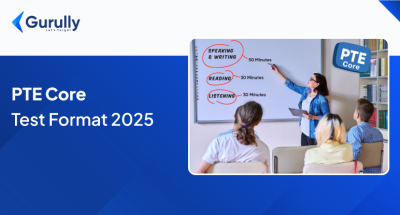Sometimes in the PTE exam, how you organize, structure, or present your response can make or break your scores in the writing section. To achieve your target score, preparing only for vocabulary and grammar is not enough; Understanding form, linguistics, and structure is equally important. These skills serve as a foundation for communicative ability in English. Your writing section’s questions are scored on these skills as well, so here is a detailed guide for scoring full in form, linguistic, and structure.
Let’s break down what each of these skills involves and what they look like at various score bands.
Form, Linguistics & Structure as Scoring Skills in PTE
What is “Form”?
Form is about fulfilling the basic task requirements:
- Meeting the word limit.
- Writing in the correct format (essay, summary, etc.).
- Keeping a check on spelling or punctuation to avoid a confused response.
- Keeping a track of your response, i.e., too short, too long, or not aligned with the task type. If it is not correct, you will get zero even if your vocabulary or grammar is correct.
Start your free PTE mock test with Gurully and get AI-powered analysis for a personalized journey.


- Kickstart your PTE prep with a free AI-scored mock test
- Boost your score with in-depth analysis & smart recommendations
What is “Linguistics”?
Linguistics refers to the quality of your language:
- Grammar accuracy
- Sentence structure variety
- Using correct tone (Formal or Informal as per the demand)
- Smooth transitions and readability
- A response that lacks grammar control or sounds too casual will negatively impact your score.
What is “Structure”?
Structure is how well your ideas are organized:
- Logical progression from introduction to conclusion
- Proper use of paragraphs and cohesive devices
- Clarity in thought presentation
- No matter if your grammar is correct and vocabulary is fine, you will still not get any score if the response seems disorganized or hard to follow.
Score Breakdown:
Score Below 50: Needs Basic Control
At this range, responses are typically:
- Do not meet the minimum word count or format.
- Contain many grammar and spelling errors.
- Lack sentence flow or cohesion.
- Jump between ideas with no clear structure.
Improve by:
- Learning the expected format for each task.
- Practicing basic sentence building.
- Using a simple paragraph structure (intro-body-conclusion).
- Avoiding short, disconnected sentences.
Score 50–59: Developing but Inconsistent
Responses in this band usually:
- Meet the format but still lack natural flow.
- Contain recurring grammar issues (articles, verb tenses).
- Have a structure that is functional but not polished.
- Use basic connectors like “and,” “but,” “because” repetitively.
Improve by:
- Prepare by practicing on different types of sentences.
- Use transition words in the sentences to improve the structure.
- Revising paragraphs to support one central idea each
- Reducing repetitive expressions
Score 60–69: Competent with Room for Refinement
You are framing:
- Clear and relevant responses that follow the task format
- Mostly correct grammar with occasional mistakes
- Logical flow with structured paragraphs
- Some sentence variety and effective use of linking words
Improve by:
- Use complex sentence structure to show your English language proficiency. (passives, conditional.
- Sharpening paragraph transitions and topic sentences
- Practicing time-bound proofreading
- Maintaining tone consistency throughout the response
Score 70+: Controlled, Confident, and Clear
This level reflects:
- Well-structured writing with a good understanding of the English language.
- Good command on spelling, punctuation, and grammar.
- Strong logical structure with seamless transitions.
- Rich and formal academic tone.
Maintain by:
- Refining your use of advanced grammar structures.
- Reviewing high-level examples for inspiration.
- Reading academic articles to mirror tone and flow.
- Proofreading, even when confident, accuracy matters.
The more you practice, the better your command over form, language, and structure becomes. Make the most of Gurully’s free question bank and section-wise tests to sharpen your skills. Our platform closely replicates the actual exam environment and provides instant, accurate scoring. Plus, our full-length PTE mock tests—designed by exam experts—include predictive questions to help you prepare strategically.
Not Sure Where to Start ? Start Now with Practicing Questions
- Al scored practice questions
- 30000+ practice questions with Al Scoring
- Practice with predictive questions

Start Writing Practice
Time: 23-30 Minutes
Questions: 14-20 questions
Difficulty Level: PTE Exam Level
Conclusion:
Strong writing in the PTE exam is not only about grammar and vocabulary, it is also about form, structure, and linguistic. The more you understand these factors and practice for improvement, the better chances there are to score high. Gurully makes it easier with real test-like practice, instant feedback, and expert-designed mock tests. Focus on writing clearly, staying organized, and using the right tone, and your PTE writing score will improve.
FAQ:
What is the structure of PTE writing?
What is the linguistic range in PTE?
Which is the toughest section in PTE?
What is the format of PTE language test?
Is PTE harder than IELTS?
Also Read:
- How to Take PTE Mock Test – Get Prepared In Advance For Real Exam
- Secrets To Score High In ‘Vocabulary’ Skill of PTE Exam
- PTE Pronunciation Score: What It Means and How You Can Improve It





